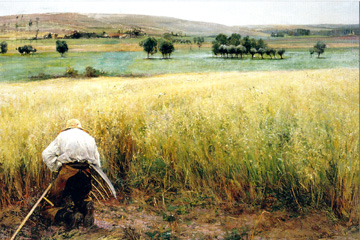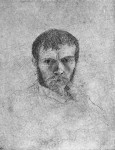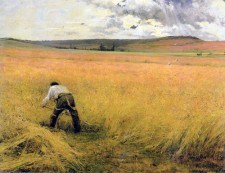
Jules Bastien-Lepage
French, 1848-1884
The Ripened Wheat, 1884
oil on canvas
37 1/2" x 43 in.
SBMA, Purchased by the Museum 1995, with funds from Suzette and Eugene Davidson and the Davidson Endowment
1995.34

Pencil Portrait of the artist created by himself in 1884, a few days before his death. Above right is another painting by Bastien-LaPage, similar to the one in the SBMA collection, painted four years prior in 1880 titled Les Bles murs (The Ripened Wheat). It is an oil on canvas in the Musee de Guezireh collection (France)
RESEARCH PAPER
The Ripening Wheat is a stirring example of the work of Jules Bastien-Lepage. Unfortunately it is also one of his last works as it was painted in 1884, the year of his death of stomach cancer at the age of 36. In the lower left hand corner he has signed the painting, J. Bastien-Lepage, Damvillers 84. Bastien-Lepage has been described as a painter who put realistic figures in impressionistic backgrounds, thus he is a perfect blending of the two schools of art in Paris at the time, realism and impressionism.
He was born in the village of Damvillers, the site of our painting. His family was poor but extremely close and he would return to the village for inspiration and care throughout his short life. His father encouraged Jules to draw and starting at age five on winter evenings he would draw articles placed on the family table, e.g. the lamp, the jug or the pen. Drawing was viewed as an important skill for obtaining a civil servant job, such as overseer of forests, bridges or highways, and thus a secure life and a pension. Although drawing was acceptable, painting was not and when Jules expressed a desire to study painting it was a shock to his family. A compromise was made, Jules would work for the postal service in Paris and study at the Ecoles des Beaux in his free hours. Jules arrived in Paris at the end of the 1867. After six months he decided he couldn’t work and learn to paint and of course the job was the activity that was given up. In order to help Jules, his mother went to work in the fields so that she could add something to small sum the family sent him each month. Bastien-Lepage joined the volunteers in the 1870 war, was injured and went home to Damvillers to recuperate. He returned to Paris in 1872 to continue his studies and work for success as much for his family as for himself.
In 1874 he was the success of the Salon with a painting of his grandfather (Le Portrait du Grandpere). It was a very realistic portrait and there are photos showing his grandfather in the same posture as the painting. The invention of the photograph was a tool for many artists and especially for those like Bastien-Lepage looking for realism or for Degas looking for a different angle that you could not get in a studio. In 1875 he was awarded the ‘Prix de Rome’ by the art section of the Paris Academy but it was taken away by the majority of the council, the resulting outrage brought him more renown than if he had been allowed to keep the prize and insured his reputation in Paris. His work now consisted largely of commissioned portraits and painting of peasant scenes and people in his village. His Joan of Arc, 1880, is cited as an example of his artistic ideas as he discards the conventional portrayals of her and presents her as a very poor and rough peasant girl. His paintings require the use of our imagination. Per George Clausen, a contemporary critic, “He will give you the visual impressions as truly as he possibly can: you may, if you please find as he has found, pathos and poetry in it; but for his part he will not help you by any comment of his own.” Bastien-Lepage doesn’t give us stories with his painting but gives us people that interest us and we are left to fill in the story.
Bastien-Lepage did not have students per se, but many painters went to paint with him in his beloved Damvillers, including J. Alden Weir. Although his work really only spans ten years, he was influential to those who knew his work in his choice of subject matter, his realistic approach and the use of photographs as models. Unfortunately because of his short career he doesn’t have the reputation that his early acclaim would seem to warrant.
Our painting The Ripening Wheat is typical of Bastien-Lepage in subject matter but not typical in the fact that the figure is facing away from us. In the catalogs almost all of his painting and sketches show faces and usually frontal faces. In our painting we see the back of the kneeling peasant and we can enter the painting but we enter it quietly and reverently. We do not want to disturb him for we aren’t certain what he is doing. Is he resting, sharpening his scythe or is he praying? Whatever you choose you are aware of Jules’ reverence for country life and the seasons of life. Given this reverence and that the painting was painted just before his death, is the scythe a symbol of his death, and if so, since the wheat is ripe is he ready?
The kneeling figure is in luminous and realistic colors. He is painted with a texture absent from the rest of the painting giving him even more emphases. The scythe is extremely realistic, we know that the blade is metal and will cut down the wheat. We can feel the coolness of the blade and the warmth of the wheat. The wheat is moving with small spots of red, this and the red on the hat and apron keep us looking at the figure and foreground. A very limited use of red in the background draws our eye up and gives a sense of depth as our eyes move in the painting. The background colors are really sketchy. As we move away from the wheat and up in the picture he uses strong horizontals to still the action. The only thing moving is the wheat apparently lightly blown by the wind.
We have a spiritual and moving work that is an example of how the unseen, the face of the figure and what he is actually doing can draw us in, engage us and enrich our lives by urging us to use our imagination.
Artist:
*1848-1884, died of stomach cancer at age 36
*From small village of Damvillers
*Family poor, Father encouraged drawing at age five, on winter evenings Jules would draw articles on the table, e.g. the lamp, the jug (p.16) as means to a civil servant job.
*Tried to combine job with painting but gave up on job to paint.
*Realistic figures in impressionistic settings.
*1874 recognition from painting of Grandfather a portrait in a landscape there are photos that show him in same pose as painting.
*1875 was awarded ‘prix de Rome’ by the art section of the Paris Academia but it was taken away by the majority on the council, the resulting outrage brought him more renown than if he had kept the prize.
*Painted peasant scenes, people in village, Joan of Arc, 1880, discarded convention and presents her as a poor peasant girl is cited as an example of his artistic ideas. See The. For critics p. 116 “he will give you the visual impression as truly as he possibly can; you may, if you please find-as he has found-pathos and poetry in it; but for his part he will not help you by any comment of his own.” –e.g. Lepage did not give us stories with his portraits but gave us people that interested us, we were left to fill in the story).
*Didn’t necessarily have students but many painters went to paint with him. E.g. J. Alden Weir, an American painter.Painting:
*Typical of Lepage in subject matter but not typical in the fact that the figure is facing away from us. Paintings and sketches in catalog show faces. This painting allows us to enter behind the man kneeling in the field.
*Reverence for country life and seasons, painted a series on seasons. Painted just before his death, is the scythe a symbol of his death, if so since the wheat is ripe is he ready for death?
*Figure in foreground in luminous and realistic colors.
*Background muted and more impressionistic e.g. trees on upper far left look like poplars but are really very sketchy. Wheat is moving with small spots of red, this and the red on the hat and apron keep us looking at the figure and foreground. Very limited use of red in background draws our eyes up to give a sense of depth as we are traveling in the painting.
*Texture is smooth except for figure-paint used to give substance to figure. Scythe is extremely realistic we know that the blade is metal.
Bibliography
Auburn, Marie-Madeleine. Jules Bastien-Lepage 1848-1884, Catalogue raisonne de l’Oeuvre. 1985
Theuriet, A. Jules Bastien-Lepage and his Art. A Memoir by Andre Theuriet. London: T. Fisher Unwin, Paternoster Square. 1892
Theuriet, A. Jules Bastien-Lepage and his Art. A Memoir by Andre Theuriet, Jules Bastien-Lepage as Artist, by George Clausen A.R.W.S. London: T. Fisher Unwin, Paternoster Square. 1892
Weisberg, Gabriel P.”P.A.J. Dagnan-Bouveret, Jules Bastienn-Lepage, and the Naturalist Instinct”, Arts Magazine, April, 1982. P 70-76.
Williamson, George. Bryan’s Dictionary of Painters and Engravers. Vol 1, London George Bell and Sons LTD 1918
Prepared for the Santa Barbara Museum of Art Docent Council by Deanna R. Major, April, 1999
Website preparation: Michele Yeadon, 2004

Jules Bastien-Lepage painted a similar painting to the one in the SBMA collection, four years prior in 1880, titled Les Bles Murs (The Ripened Wheat). It is an oil on canvas in the Musee de Guezireh collection (France).
SBMA CURATORIAL LABELS
In compositional construction, this painting strongly resembles Bastien-Lepage’s breakthrough picture called Haymaking, which established him as the leading painter of the Naturalist school. Academically trained and equipped with the illusionistic skill to describe the finery of his sitters in society portraiture with as much ease as the countryside of his youth in the village of Damvillers in northeastern France, Bastien-Lepage dominated the Parisian art scene in the years following the emergence of Impressionism. Although Bastien-Lepage’s technical sophistication may seem very distant from Van Gogh’s decidedly un-academic technique, he was still considered by the Dutch artist to have the requisite first-hand knowledge of agrarian daily life to render it without affectation.
Bastien-Lepage’s choice to depict the harvest, a conventional metaphor for man’s God-given relationship to nature, would have appealed greatly to Van Gogh, who treated the subject over and over again, though without any overt Christian symbolism.
- Through Vincent's Eyes, 2022
